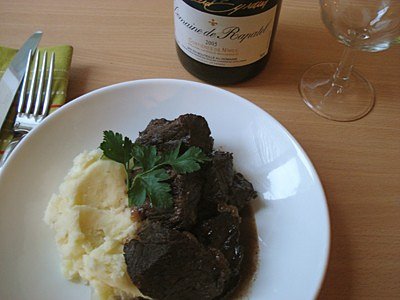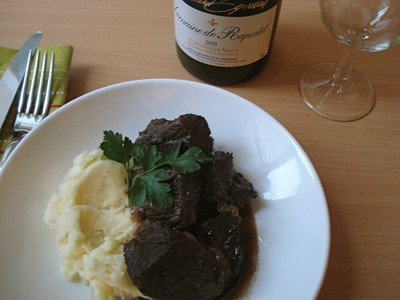Daube de Boeuf

Sat 2 Jan 2010

Though loyal to Julia Child’s Boeuf Bourguignon, I felt like a change this winter. There is a recipe for beef stew in Alice Waters’s The Art of Simple Food, and I was surprised to see the addition of orange peel and cloves to the pot. She includes tomatoes, too, but that wasn’t what I had in mind. I turned to the beef and veal volume of The Good Cook series, published by Time-Life in the 1970s. (These books are fantastic. Look for them at used bookstores or online.) There I found a recipe for Daube de Boeuf that also included orange and spices. It’s attributed to one C. Chanot-Bullier, who wrote a book called Vieilles Recettes de Cuisine Provençale. Suddenly the Alice Waters recipe made sense—it is no secret that her cooking is inspired by Provence.
All beef stews are basically the same: the meat is browned, usually in bacon fat; vegetables and seasonings are added to the pot; and the whole thing is covered with wine and/or stock and kept at a bare simmer for a few or several hours, until the meat is very tender. At this point it can be served directly from the pot, but here I turn back to Julia Child, who removes the meat, strains the vegetables from the cooking liquid and returns the beef to the pot with the smooth sauce. It sounds complicated, but it can all be done in advance, and the result is more elegant.
The wine you choose to cook with should be drinkable but not expensive. Save your money for the stuff that will go in your glass. For a nice bottle to drink, a hearty Rhône red would be perfect. See what Girls’ Guide to Paris contributor Diana Rice has to say about these wines.
Then start cooking!
Daube de Boeuf
Adapted from The Good Cook: Beef and Veal (Time-Life) and The Art of Simple Food, by Alice Waters (Potter).
Serves 4 to 6.
1 tablespoon (15 ml) cooking oil
4 oz (115 g) bacon, cut into ½” (1½ cm) pieces
2½–3 lbs (1 kg) beef chuck, cut into 1½” (4 cm) chunks, rinsed and dried thoroughly with paper towels
Salt and freshly ground black pepper
2 medium onions, sliced
1 carrot, cut into 1″ (2½ cm) pieces
3 cloves garlic, peeled and crushed
1 tablespoon (9 g) flour
2 sprigs fresh thyme
2 sprigs fresh parsley
1 bay leaf
3 peppercorns
3 whole cloves
1 cinnamon stick (or ¼ teaspoon ground cinnamon)
A 2″ (5 cm) strip of fresh orange zest (use a vegetable peeler to achieve this)
1 bottle (3¼ cups/750 ml) dry red wine (or half wine and half meat stock)
1. Season the beef generously with salt and pepper and set aside. In a heavy 9″ oven-proof casserole (a Le Creuset Dutch oven is perfect here) heat the oil over medium heat and sauté the bacon in it until it is lightly browned and has released some of its fat. Remove the bacon from the pan with a slotted spoon and set aside.
2. Increase the heat to medium high. When the oil is nearly smoking, brown the beef on all sides, a few pieces at a time. (If you crowd the pan, the meat will steam and not brown properly, so do it in batches.)
3. When all of the beef is browned, turn the heat down to medium and remove the beef and all but 1 tablespoon of fat from the pan. Put the onion, carrot and garlic in the pan, season with salt and pepper, and cook for several minutes until lightly browned and starting to soften.
4. Return the beef and bacon to the pan with the vegetables. Sprinkle the flour into the pan and stir everything together so that the meat and vegetables are evenly coated with flour.
5. Add the herbs, spices and orange zest to the pan, then pour in enough wine/stock to just cover the contents. Bring the stew to a simmer on the stove top, cover it and transfer it to the oven. After 15 minutes or so, check to make sure the stew is barely simmering—if it isn’t simmering at all, turn up the heat a little, and if it’s rapidly bubbling, turn it down. Continue cooking for at least 2½ or 3 hours, until the meat is very tender.
6. When the meat is ready, remove the pot from the oven. Carefully remove the beef, then pour the cooking liquid through a strainer set over a bowl big enough to hold all of the sauce.
7. Put the strained sauce back in the pan. Taste it for seasoning and add salt and pepper if necessary. The sauce should be thick enough to lightly coat a spoon. If it isn’t, bring it to a boil and reduce it slightly.
8. Return the beef to the sauce and reheat thoroughly before serving.
Serving Suggestions and Variations
This recipe can be made a day in advance. A dish like this cries out for mashed potatoes, though I’ve also seen daubes served with buttered noodles. Garnish it with fresh parsley if you like. Try adding black olives or prunes to the sauce. You can make this stew with all wine, or replace some of it with meat or veal stock—the finished dish will be richer and the sauce a bit thicker.